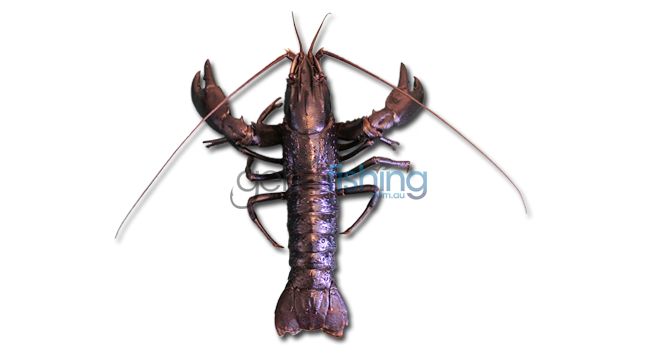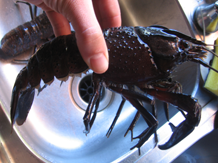Species ID
View AllSmooth Marron

Marron are a large-growing freshwater crayfish endemic to south-west WA. They are generally jet-black or brown in colour but the natural colour range also includes red, striped, and cobalt blue variations. They have 10 legs which include a pair of large claws and a pair of pincers used when feeding. Marron are most active at night and although they have eyes they also rely on a pair of sensitive antennae and antennules to feel their way around. Excluding fishing in your own personal dam, fishing for these succulent delicacies is limited to just four weeks of the year between January and February.
The hairy marron (Cherax tenuimanus) is a close relative to the smooth marron and is only found in the upper reaches of Margaret River. They are distinguished by short hairs that cover the carapace, abdomen and sometimes tail. They are critically endangered and should never be targeted.
Common size
70-90mm carapace length
Related species
“Hairy marron (Cherax tenuimanus), Gilgies (Cherax quinquecarinatus and Cherax crassimanus), Koonacs (Cherax preissii and Cherax glaber)
Habitat
Marron are found in freshwater dams and waterways. They prefer habitats with permanent water and plenty of fallen logs and debris to seek refuge in. Water temperatures of 15-25 degrees Celsius is optimum for marron.
Reproduction
Marron start their life as tiny larvae, hatched from eggs beneath their mother’s tail. Here they cling to fine hairs for a few weeks before dropping off to fend for themselves. Marron reach sexual maturity after 2-3 years and spawn in spring. Average sized females will produce around 400 eggs and fertilise them with a sperm packet passed on by the male during mating. The cycle then repeats.
Diet
Marron are omnivores that feed on all sorts of dead or alive material from the bottom of the river or dam. Their diet includes algae, decaying plant material, small invertebrates, small fish, fish eggs and other plant and animal detritus.
Catch care
Care for your marron humanely before cooking by keeping them alive in a cool, damp hessian bag or sack. Do not try to keep them in a bucket of water as they will quickly use up all the oxygen and suffocate. Putting them in the freezer for a few minutes will help slow them down while you prepare to kill and cook them. WA fisheries suggest the correct method to kill them is to “insert a knife between the eyes and cut through the centreline of the head and thorax (splitting) in one quick movement”. For more information see the ‘Recreational fishing for marron guide 2014‘
Information courtesy Department of Fisheries WA
For information on legal ways to catch marron as well as open season times and other rules and regulations see the ‘Recreational fishing for marron guide 2014‘
Marron are endemic to WA’s south-west. They are currently found between the Hutt River north of Geraldton and Esperence and inland to the WA goldfields. Prior to transportation by people they were limited to a smaller distribution between Harvey and Albany.
5 star. Marron are an amazingly delicious freshwater crustacean. They are similar in taste to lobster, although slightly more smooth and delicate, and are cooked in similar ways.
The most common ways recreational fishers cook marron is to either boil them whole and sprinkle with salt or butterfly and grill with garlic and butter. They are somewhat of a delicacy and for this reason they can be found in a multitude of different recipes worthy of the most exquisite fine dining restaurants around the world. If you’ve never tried marron you are seriously missing out and we suggest that come next marron season you get down to WA south west and catch some for yourself.

- Are a member of the family Parastacidae (freshwater crayfish)
- Can grow to 40cm and 2.2kg
- They are the third largest freshwater crayfish in the world
- Marron are endemic to south-west WA
- Normally black or brown in colour, the natural colour range includes the less common red or stunning cobalt blue varieties
- Often confused with Hairy Marron (Cherax tenuimanus)
- Large females can produce up to 800 eggs per year
- Good eating





























